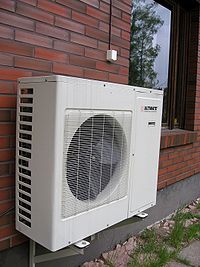
Photo from wikipedia
Abstract A simple and accurate method to calculate the energy consumption of a water source heat pump system is important for analyzing its economic and social benefits. This paper presents… Click to show full abstract
Abstract A simple and accurate method to calculate the energy consumption of a water source heat pump system is important for analyzing its economic and social benefits. This paper presents a study on performance of a lake-water source heat pump unit, the calculation models of inlet water temperature on lake water side was obtained. Our results have shown that the hourly temperature of inlet water on lake water side and outlet water on user side would change a little within a day, and there was a linear relationship between daily average lake-water temperature and daily average air dry-bulb temperature. The measured daily average outlet water temperature on user side during a whole cooling/heating season changed in a little margin. Then a simplified model for coefficient of performance (COP) calculation of unit was proposed, the feasibility was validated through data analysis. A simplified method has therefore been developed to calculate and predict energy consumption of surface water source heat pump (SWHP) unit and will therefore enable energy efficient operation of water source heat pump for HVAC (heating, ventilating and air-conditioning) applications in buildings.
Journal Title: Applied Thermal Engineering
Year Published: 2017
Link to full text (if available)
Share on Social Media: Sign Up to like & get
recommendations!